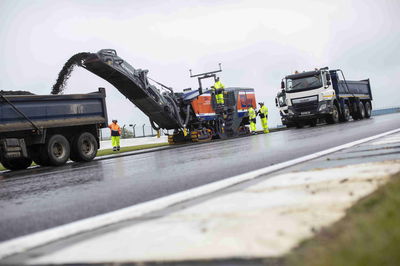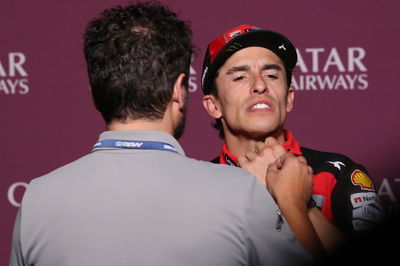New Silverstone surface ‘more durable, ten times stronger’
As the extensive works on Silverstone’s new track surface nears its conclusion, circuit management are confident it has tarmac “three times as durable and ten times stronger” than what was previously in place.
Working to overcome the disaster that was the 2018 British MotoGP – the race that never was – Silverstone has hired track designer Dromo to investigate the causes of the past failures, advise on relevant equipment use and oversee the preparations of the revised ground and laying of tarmac.

As the extensive works on Silverstone’s new track surface nears its conclusion, circuit management are confident it has tarmac “three times as durable and ten times stronger” than what was previously in place.
Working to overcome the disaster that was the 2018 British MotoGP – the race that never was – Silverstone has hired track designer Dromo to investigate the causes of the past failures, advise on relevant equipment use and oversee the preparations of the revised ground and laying of tarmac.
Contractors Tarmac has been hired to put the asphalt in place, with the circuit extremely confident work will be finished well before the Formula1 British Grand Prix that gets underway on 12th July.
The job began on 10th June to rip up the old surface, guilty of possessing severe bumps as well as a failure to drain rainwater away. Sophisticated technologies, included GPS Guided Planing, have been adopted to ensure the finished surface is exactly as Dromo had designed.
Silverstone Managing Director Stuart Pringle met with select media at the Catalan Grand Prix to go through the changes in place and unequivocally state, “I’m completely confident this will make us one of the best tracks in the world, if not the best track in the world.”
“We spent a lot of time this year trying to understand what went wrong and what we need to do to put it right,” said Pringle.
“So what are we doing differently this time? We had previously used a contractor that we effectively gave a design and build contract to. That is how we had done previous resurfacing work, and that was what was done.
“We have used this opportunity, not just to resurface the track because it was a bit bumpy and it brought water at places, but to actually try and really get down to the root cause of things. So we have spent a lot of time scanning the track over the last year.”
Dromo has an established history of track design with Argentina’s Termas de Rio Hondo Circuit among those found in its portfolio. The Italian company was also responsible for the recent resurfacing and modifications of the Sepang International Circuit in 2016.
Going into what Dromo has brought in terms of expertise, Pringle confided, “They’ve built up a computer model which is a new profiling of the circuit. More camber, more form, more dissipating of water, crowns where necessary.”
It was the lack of such crowns on the Hangar Straight in the previous design that led to a significant degree of standing water during and after showers.
This ultimately led to a three-rider crash during last year’s MotoGP FP4 session, when Tito Rabat’s right leg was fractured in three places after getting hit by Franco Morbidelli’s errant Honda.
“[Dromo] had some very exacting specifications,” explained Pringle. “They said, ‘We need this make of planer. It has to be a track vehicle to play this thing in the background. It’s got to be track and not wheels.’
“Tarmac didn’t have them, so they bought two of them. They had one; now [they have] three. You needed three. They went out with a half-million quid a pop they bought two of them for this job. They’ll use them again, but you’ll see a lot of men and machinery around the place.”
Sourcing materials from Shropshire, Pringle is sure Bitumen, the material that is mixed with clay to create the tarmac, is more robust than before.
“[They are] Using bitumen [that is] ten times more durable, three times stronger. We have complete confidence laying this now ahead of Formula 1. There was a suggestion that we were laying it too close by somebody, we were laying it too close to Formula 1.
“Would that not be a problem? No. We are aware of that. It has been designed that it is way stronger than anything we’ve ever laid. It will mix together. This is a commitment that I hope I don’t have to do again. I’m 48 years old this year, and this should see me out of my stay at Silverstone.”
“There’s some proper science going in. It’s a serious financial commitment by the BRDC. It’s cost us over a million quid more than the last resurfacing cost.”
On the cost involved, Pringle was unwilling to give specific figures. “We’re not talking about the cost, unfortunately, because Tarmac are a bit jumpy about that,” he said. “But it’s a multi-seven figure sum. If you have a poke around, there’s some reasonably educated guess out on the net somewhere.”
Upon announcing it would begin resurfacing in June, Silverstone also confirmed it had agreed a one-year extension to host the British MotoGP event. Before its contract with Dorna ran to 2020; now it goes to 2021.
“I’m pleased to say that Dorna have recognised our commitment to MotoGP with this resurfacing by saying, ‘You’re doing the right thing. We really like what you’re up to, and the race is great there anyway.’
“We agreed a one-year extension to our previous contract, which had two years to run. So effectively we’ve got MotoGP up until 2021. We’ve got ’19, ’20 and ’21.
“I hope by then our hotel will be open trackside opposite the wing for F1 next year. We’ll have other accommodations. With this track, I’m completely confident this will make us one of the best tracks in the world, if not the best track in the world. One of the old, truly historic tracks, but with state-of-the-art asphalt.”











